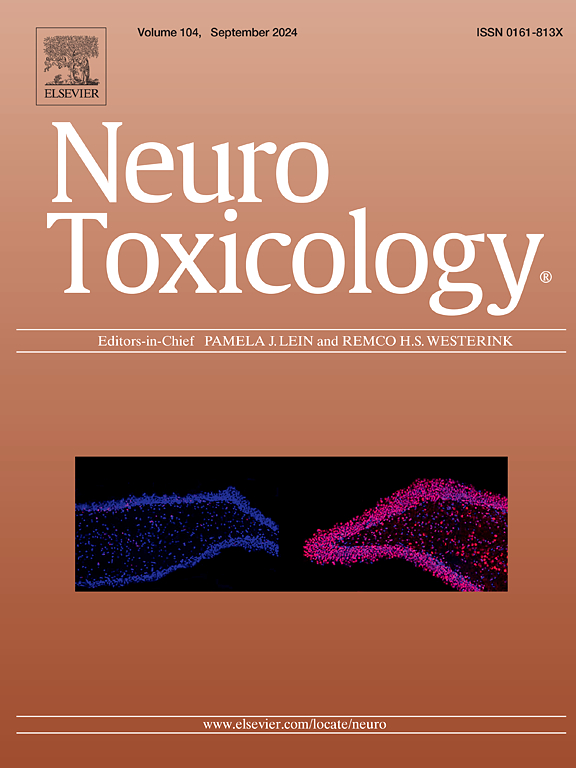产前BPB/BPAF暴露通过化合物特异性转录失调和神经发育通路改变诱导雄性小鼠后代抑郁样行为
IF 3.9
3区 医学
Q2 NEUROSCIENCES
引用次数: 0
摘要
双酚A (BPA)及其替代品的神经发育毒性已经引起了人们的极大关注。然而,两种被广泛检测到的环境污染物——bpaf和bpb——与青少年抑郁症之间的关系及其潜在机制在很大程度上仍不清楚。在此,我们建立了一个产前BPB/BPAF暴露动物模型,并证明了这种暴露会导致断奶雄性后代的抑郁和焦虑样行为。通过皮质组织的RNA测序,结合抑郁相关转录因子(TFs)的筛选,靶基因的功能富集分析和枢纽基因的鉴定,我们发现BPB和BPAF通过不同的转录调控网络和生物学过程驱动疾病进展。具体而言,BPB显著下调TFs Lhx8和Foxp1,靶向中枢基因(如Alb、Apoa1、Apoa2、Fga、Serpina1b、Fos、Rassf6、Rassf10、Rassf7、Moap1),破坏神经肽、突触、转录相关的生物学过程。相比之下,BPAF显著上调TF Neurod1,其调节中枢基因(如Rpl26、Mrpl3、Rpl35、Mrpl1、Kcnd3)参与神经元细胞体和大脑皮层发育。分子对接进一步证实了BPB与Lhx8/ Foxp1、BPAF与Neurod1之间通过氢键或疏水相互作用介导的潜在结合相互作用。这些发现表明,BPB和BPAF通过对转录网络的化合物特异性破坏诱导雄性后代的抑郁样行为,从而改变神经发育途径,这可能是由于它们与不同tf的不同结合亲和力。本研究为BPA替代品相关的神经发育毒性提供了新的视角,为BPAF/ bpb相关神经精神疾病的风险评估和治疗靶向提供了重要意义。本文章由计算机程序翻译,如有差异,请以英文原文为准。
Prenatal BPB/BPAF exposure induces depression-like behavior in male mice offspring via compound-specific transcriptional dysregulation and neurodevelopmental pathway alterations
The neurodevelopmental toxicity of bisphenol A (BPA) and its substitutes has garnered significant attention. However, the association between two widely detected environmental contaminants—BPAF and BPB—and adolescent depression, along with their underlying mechanisms, remain largely unclear. Here, we established a prenatal BPB/BPAF exposure animal model and demonstrated that such exposure induces depression- and anxiety-like behaviors in weanling male offspring. Through RNA sequencing of cortical tissues, combined with screening of depression-associated transcription factors (TFs), functional enrichment analysis of target genes, and identification of hub genes, we revealed that BPB and BPAF drive disease progression via distinct transcriptional regulatory networks and biological processes. Specifically, BPB significantly downregulate the TFs Lhx8 and Foxp1, targeting hub genes (e.g., Alb, Apoa1, Apoa2, Fga, Serpina1b, Fos, Rassf6, Rassf10, Rassf7, Moap1) to disrupt neuropeptide-, synapse-, transcription- related biological processes. In contrast, BPAF significantly upregulate the TF Neurod1, which modulate hub genes (e.g., Rpl26, Mrpl3,Rpl35, Mrpl1, Kcnd3) involved in neuronal cell body and cerebral cortex development. Molecular docking further confirmed potential binding interactions between BPB and Lhx8/ Foxp1, as well as BPAF and Neurod1, mediated by hydrogen bonding or hydrophobic interactions. These findings demonstrate that BPB and BPAF induce depression-like behavior in male offspring through compound-specific disruption of transcriptional networks, which alter neurodevelopmental pathways, potentially due to their divergent binding affinities to distinct TFs. This research offers new perspectives on the neurodevelopmental toxicity associated with BPA alternatives, offering critical implications for risk assessment and therapeutic targeting of BPAF/BPB-related neuropsychiatric disorders.
求助全文
通过发布文献求助,成功后即可免费获取论文全文。
去求助
来源期刊

Neurotoxicology
医学-毒理学
CiteScore
6.80
自引率
5.90%
发文量
161
审稿时长
70 days
期刊介绍:
NeuroToxicology specializes in publishing the best peer-reviewed original research papers dealing with the effects of toxic substances on the nervous system of humans and experimental animals of all ages. The Journal emphasizes papers dealing with the neurotoxic effects of environmentally significant chemical hazards, manufactured drugs and naturally occurring compounds.
 求助内容:
求助内容: 应助结果提醒方式:
应助结果提醒方式:


